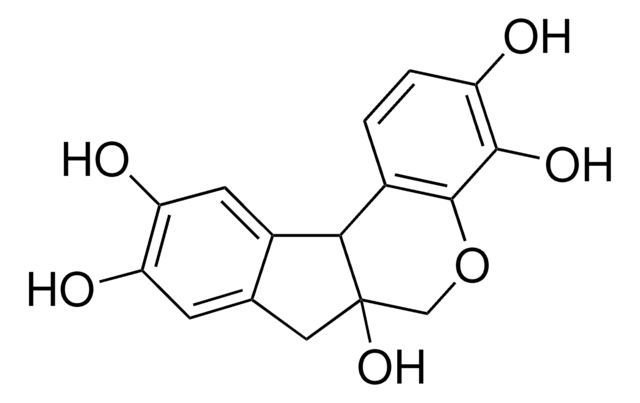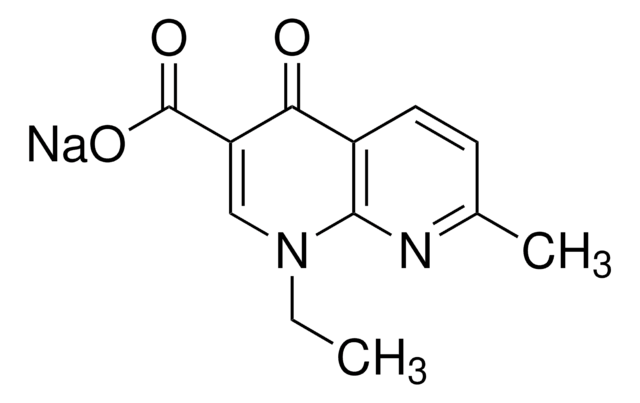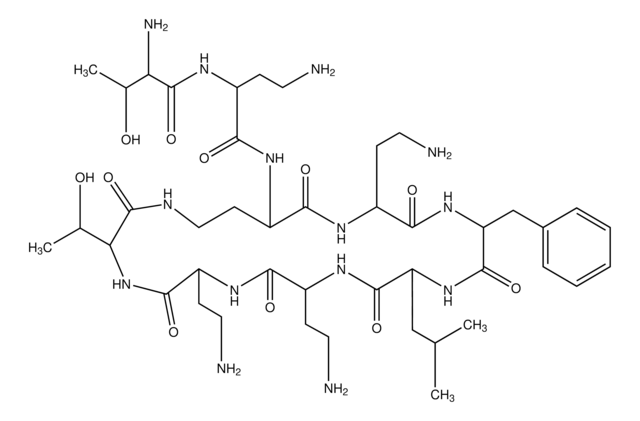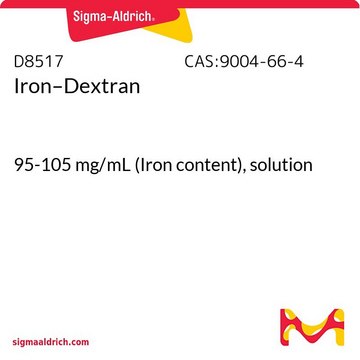5291
Polymyxin B Sulfate
Polymyxin B Sulfate, CAS 1405-20-5, is an antibiotic that is effective against Gram-positive bacteria. Inhibits phospholipid-sensitive Ca2+-dependent protein kinases.
Sinonimo/i:
Polymyxin B Sulfate, Aerosporin
About This Item
Prodotti consigliati
Livello qualitativo
Forma fisica
solid
Produttore/marchio commerciale
Calbiochem®
Condizioni di stoccaggio
OK to freeze
Colore
white to off-white
Solubilità
water: 25 mg/mL
Condizioni di spedizione
ambient
Temperatura di conservazione
10-30°C
InChI
1S/C48H82N16O13.H2O4S/c1-27(2)24-37-47(76)59-32(11-19-52)41(70)56-31(10-18-51)43(72)61-35(14-22-65)39(68)54-21-13-34(45(74)57-33(12-20-53)44(73)64-38(48(77)63-37)25-28-6-4-3-5-7-28)60-42(71)30(9-17-50)58-46(75)36(15-23-66)62-40(69)29(8-16-49)55-26-67;1-5(2,3)4/h3-7,26-27,29-38,65-66H,8-25,49-53H2,1-2H3,(H,54,68)(H,55,67)(H,56,70)(H,57,74)(H,58,75)(H,59,76)(H,60,71)(H,61,72)(H,62,69)(H,63,77)(H,64,73);(H2,1,2,3,4)
HNDFYNOVSOOGDU-UHFFFAOYSA-N
Descrizione generale
Applicazioni
- to neutralize the endotoxins in bovine serum albumin
- in the in vitro treatment of hepatic stellate cells (HSCs)
- as an antibiotic in collateral sensitivity and cross-resistance analysis in Escherichia coli
Azioni biochim/fisiol
Attenzione
Altre note
Ngezahayo, A. and Kolb, H.A. 1993. Pflugers Arch.422, 413.
Kubo, M. and Okada, Y. 1992. J. Physiol.456, 351.
Strasser, S.H., et al. 1992. Circ. Res.70, 1304.
Hegemann, L., et al. 1991. Eur. J. Pharmacol.207, 17.
Inaba, H. and Filkins, J.P. 1991. Am. J. Physiol.261, R26.
Marra, M.N., et al. 1990. J. Immunol.144, 662.
Note legali
Avvertenze
Warning
Indicazioni di pericolo
Consigli di prudenza
Classi di pericolo
Acute Tox. 4 Oral
Codice della classe di stoccaggio
11 - Combustible Solids
Classe di pericolosità dell'acqua (WGK)
WGK 3
Punto d’infiammabilità (°F)
Not applicable
Punto d’infiammabilità (°C)
Not applicable
Certificati d'analisi (COA)
Cerca il Certificati d'analisi (COA) digitando il numero di lotto/batch corrispondente. I numeri di lotto o di batch sono stampati sull'etichetta dei prodotti dopo la parola ‘Lotto’ o ‘Batch’.
Possiedi già questo prodotto?
I documenti relativi ai prodotti acquistati recentemente sono disponibili nell’Archivio dei documenti.
I clienti hanno visto anche
Il team dei nostri ricercatori vanta grande esperienza in tutte le aree della ricerca quali Life Science, scienza dei materiali, sintesi chimica, cromatografia, discipline analitiche, ecc..
Contatta l'Assistenza Tecnica.









